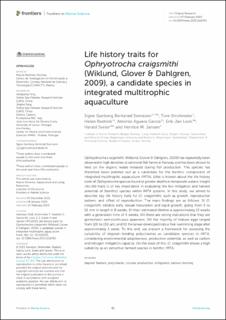| dc.contributor.author | Svensson, Signe Gunborg Bentzröd | |
| dc.contributor.author | Strohmeier, Tore | |
| dc.contributor.author | Rastrick, Helen | |
| dc.contributor.author | Aguera, Antonio | |
| dc.contributor.author | Lock, Erik Jan Robert | |
| dc.contributor.author | Sveier, Harald | |
| dc.contributor.author | Jansen, Henrice M | |
| dc.date.accessioned | 2023-05-31T11:07:21Z | |
| dc.date.available | 2023-05-31T11:07:21Z | |
| dc.date.created | 2023-03-07T19:38:48Z | |
| dc.date.issued | 2023 | |
| dc.identifier.citation | Frontiers in Marine Science. 2023, 10 . | en_US |
| dc.identifier.issn | 2296-7745 | |
| dc.identifier.uri | https://hdl.handle.net/11250/3069478 | |
| dc.description.abstract | Ophryotrocha craigsmithi (Wiklund, Glover & Dahlgren, 2009) has repeatedly been observed in high densities at salmonid fish farms in Norway and has been shown to feed on the organic waste released during fish production. This species has therefore been pointed out as a candidate for the benthic component of integrated multitrophic aquaculture (IMTA). Little is known about the life history traits of Ophryotrocha species found at greater depths in temperate waters. Insight into life traits is of key importance in evaluating the bio-mitigation and harvest potential of (benthic) species within IMTA systems. In this study, we aimed to describe key life history traits for O. craigsmithi, such as growth, reproductive pattern, and offset of reproduction. The main findings are as follows: (I) O. craigsmithi exhibits early sexual maturation and rapid growth, going from 5 to 16 mm in length in 8 weeks; (II) their estimated lifetime is approximately 15 weeks with a generation time of 4 weeks; (III) there are strong indications that they are gonochoric semicontinuous spawners; (IV) the majority of mature eggs ranged from 120 to 150 µm; and (V) the larvae developed into a free-swimming stage after approximately 1 week. To this end, we present a framework for assessing the suitability of deposit-feeding polychaetes as candidate species in IMTA, considering environmental adaptiveness, production potential, as well as carbon and nitrogen mitigation capacity. On the basis of this, O. craigsmithi shows a high suitability as an extractive farmed species in benthic IMTA. | en_US |
| dc.language.iso | eng | en_US |
| dc.title | Life history traits for Ophryotrocha craigsmithi (Wiklund, Glover & Dahlgren, 2009), a candidate species in integrated multitrophic aquaculture | en_US |
| dc.title.alternative | Life history traits for Ophryotrocha craigsmithi (Wiklund, Glover & Dahlgren, 2009), a candidate species in integrated multitrophic aquaculture | en_US |
| dc.type | Peer reviewed | en_US |
| dc.type | Journal article | en_US |
| dc.description.version | publishedVersion | en_US |
| dc.source.pagenumber | 11 | en_US |
| dc.source.volume | 10 | en_US |
| dc.source.journal | Frontiers in Marine Science | en_US |
| dc.identifier.doi | 10.3389/fmars.2023.1116765 | |
| dc.identifier.cristin | 2132136 | |
| cristin.ispublished | true | |
| cristin.fulltext | original | |
| cristin.qualitycode | 1 | |
